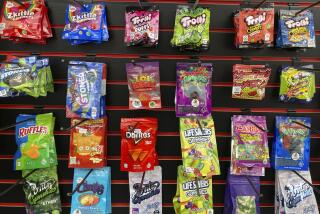Scientist’s research produces a dangerous high
John W. Huffman is a bearded, elfin man, a professor of organic chemistry who runs model trains in his basement and tinkers with antique cars. At 79, he walks a bit unsteadily after a couple of nasty falls.
Relaxing on his back porch in the Nantahala National Forest, watching hummingbirds flit across his rose beds, Huffman looks every bit the wise, venerable academic in repose.
But this courtly scientist unwittingly contributed to the spread of “designer marijuana” so potent that the Drug Enforcement Administration has declared some of what he created illegal.
Huffman’s years of scientific research at Clemson University on the interaction between drugs and brain receptors led to so-called fake marijuana with effects far more powerful — and dangerous — than garden-variety marijuana. “Spice,” “K-2,” “Skunk” and similar products made using the chemical compounds he formulated have surged in popularity in recent years.
That prompted the Drug Enforcement Administration in March to temporarily list “stealth marijuana” products containing three cannabinoid compounds invented by Huffman as Schedule 1 drugs illegal to sell or possess.
Some interviewers and critics have blamed Huffman for turning an entire generation onto “monster weed.”
“It’s become a royal pain in the rear end,” Huffman said the other day, reflecting on the unwelcome attention his research has received. “I had a TV station in Moscow accuse me of trying to poison America’s youth.”
In that interview, live on Russian radio, he said, his responses seemed slow because of a satellite delay — so slow that the questioner accused him of smoking his own creations.
In a separate conversation, a BBC interviewer “basically asked me when I stopped beating my wife,” he said. “They accused me of creating all these horrible drugs.”
But Huffman laughs as he describes emails assuming he has created a super form of medical marijuana or has profited by designing lucrative marijuana substitutes. “We were not. It was all just basic science,” he said. To counter misinformation, he and Clemson have devised a boilerplate statement describing his research and warning against consuming synthetic marijuana.
That hasn’t stopped alert entrepreneurs from using Huffman’s formulas, published in scientific journals. Their products, often sold as “herbal incense” and smoked like traditional marijuana, can produce seizures, hallucinations, tremors, paranoia, convulsions, high blood pressure and rapid heart rate, say emergency room doctors.
Poison control centers have received 4,500 calls over the last two years from people using fake marijuana, according to the American Assn. of Poison Control Centers.
There also has been “a significant jump” in the last couple of years in emergency room admissions, said DEA spokesman Lawrence Payne. “Unfortunately, there are many retailers out there who care nothing about the products they are selling and what they do to kids,” he said.
No studies have been completed on fake marijuana’s effects on human health or behavior, according to the National Institute on Drug Abuse. But Huffman warns that the compounds can cause high blood pressure, elevated heart rate and “serious and unpredictable psychological effects.”
Of the five cannabinoid compounds declared temporarily illegal by the DEA, the most widely used are three invented by Huffman and bearing his initials: JWH-018, JWH-073 and JWH-200.
“We didn’t think anything of these compounds. We wrote papers about them and that was it — or so we thought,” he said.
His research colleagues tease him, asking him what mad compounds he’s cooked up lately, or suggesting he open a chain of head shops. A little old lady at his church told him, “Oh, it’s so awful what they’ve done with your stuff!”
On a recent trip to Myrtle Beach, S.C., Huffman got a kick out of a sign in front of a head shop that read: “K-2 — Two For The Price of One.”
And when he gave a talk recently to a group called the Carolina Cannabinoid Cooperative, Huffman titled it, “JWH-018 — A Good Compound Gone Bad.”
From 1984 until early this year, Huffman and his team at Clemson created 460 synthetic cannabinoid compounds for tests on lab animals. Under a $2-million federal drug grant, they studied the interaction between drugs and brain receptors.
“These receptors don’t exist so that people can smoke marijuana and get high,” Huffman said. “They play a role in regulating appetite, nausea, mood, pain and inflammation.”
Synthetic cannabinoids are structurally different from THC, the active ingredient in marijuana. But they have the same biological effects on the human body, which is why they are useful in research.
In tests on lab animals, some have shown promise in developing treatments for pain and inflammation and some skin cancers, Huffman said. But because of their powerful effects on brain receptors, it’s extremely risky to ingest them.
“These things are dangerous — anybody who uses them is playing Russian roulette,” Huffman said. “They have profound psychological effects. We never intended them for human consumption.”
But after Huffman’s team published its work, opportunists who saw a ready market in stoners seeking stronger highs grabbed the formulas. They mixed the pale, amber, gummy compounds with benign herbs to resemble marijuana.
Huffman said he first got calls in early 2009 about head shops selling products based on his formulas.
Although he was irritated that people were smoking his creations to get high, he was not entirely surprised.
The effects of JWH-018 can be 10 times stronger than those of THC, the active compound in marijuana. Some of his more complex compounds are even more potent, he said, and carry an even higher risk of hallucinations and psychosis.
“I always had a hunch that someday somebody would say: ‘Hey, let’s try smoking them.’ And lo and behold, that’s what happened,” he said.
Huffman said other cannabinoids among the 460 are very difficult to make, even for scientists. But the three of his compounds outlawed by the DEA — especially JWH-018 — are easily produced.
“You can make them in two steps from commonly available starting materials, which is why people jumped on these ones,” Huffman said.
Most of the chemicals are imported from overseas manufacturers — especially in China — but underground labs in the U.S. increasingly are producing and synthesizing them, said Payne, the DEA spokesman.
The agency is investigating several large-scale importers and distributors, said agency spokeswoman Barbara Carreno. In August, authorities in Louisiana seized 7,200 grams of synthetic marijuana intended for sale at $25 to $30 per packet, for an estimated street value of $80,000 to $130,000. The products had names like White Widow, Cajun Spice and Voodoo Remix.
But the DEA doesn’t have the resources to study all 460 of Huffman’s compounds, plus those created by others, Carreno said. That means any products containing cannabinoids other than the five listed by the DEA technically remain legal.
If the Department of Health and Human Services recommends outlawing the five listed cannabinoids, they would remain illegal for six months. The DEA would then begin public notices and other bureaucratic procedures to permanently outlaw them. Steps to make other cannabinoids illegal could follow.
Huffman supports banning them. But he also favors legalizing and taxing marijuana.
“You can’t overdose on marijuana, but you might on these compounds,” he said. “These things are dangerous, and marijuana isn’t, really.”
Huffman recently retired from Clemson, but keeps an office at the university. He mainly spends his days in the idyllic hamlet of Sylva, where his back porch offers spectacular mountain views. He still gets phone calls “from little papers in East Podunk, Ark.,” he said, asking about the potent fake pot he supposedly invented.
Huffman’s real scientific legacy is his research on brain and central nervous system receptors. If you want to talk about “really good stuff,” he said, consider JWH-133, another compound his team created.
“It’s the best stuff we’ve done in terms of scientific value,” he said.
The compound has been shown, in mice, to shrink brain tumors and lead to regression of non-melanoma skin cancers, suggesting a potential use in chemotherapy.
Huffman has never considered smoking his compounds, but he did smoke marijuana — once. It was in the mid-1990s, at a research conference in Arizona.
Two researchers flew in from Amsterdam with “very high-quality Dutch hash” tucked into a matchbox, he said. They offered. He smoked — scientific curiosity prevailed.
The effects were similar to two-and-a-half martinis, he recalled. And the smoke burned his throat.
“I decided to stick to martinis,” the professor said. “They’re legal.”
More to Read
Start your day right
Sign up for Essential California for news, features and recommendations from the L.A. Times and beyond in your inbox six days a week.
You may occasionally receive promotional content from the Los Angeles Times.







